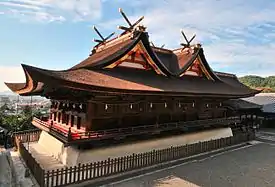Kibitsu Shrine (Bitchū)
Kibitsu Jinja (吉備津神社) is a Shinto shrine in the Kibitsu neighborhood of Kita-ku, Okayama in Okayama Prefecture, Japan. It is the ichinomiya (first shrine) of former Bitchū Province. The shrine’s main festivals are held on the second Sunday in May and October 15th each year.[1]
| Kibitsu Jinja 吉備津神社 | |
|---|---|
 | |
| Religion | |
| Affiliation | Shinto |
| Deity | Kibitsuhiko-no-mikoto |
| Festivals | Second Sunday in May and October 15th each year |
| Location | |
| Location | 931 Kibitsu, Kita-ku, Okayama-shi, Okayama-ken 701-1341 |
 Kibitsu Jinja  Kibitsu Shrine (Bitchū) (Japan) | |
| Geographic coordinates | 34°40′14.4″N 133°51′2.2″E |
| Website | |
| Official website | |
Overview
The Kibitsu Jinja is located in the western part of Okayama city, facing north at the northwestern foot of Mount Kibi-Nakayama (elevation 175 meters) on the border between former Bizen Province and Bitchū Province. The mountain has been worshipped as a sacred mountain from ancient times, and both the Kibitsu Jinja and Kibitsuhiko Jinja are located at its northeastern foot. Kibitsu Jinja was originally the general guardian of Kibi Province, but due to the division of Kibi Province into three provinces, it became the ichinomiya of Bitchū, and bunrei from this shrine created the ichinomiya of Bizen Province (Kibitsuhiko Jinja) and Bingo Province (Kibitsu Shrine).
The Honden-Haiden, which was re-built by Ashikaga Yoshimitsu, is a National Treasure and the sole exemplar of the kibitsu-zukuri style of architecture, although the Soshidō of Hokekyō-ji is now believed to have been modeled thereon.[2][3] In addition, the three shrine buildings are designated as National Important Cultural Properties, and a special Shinto ritual "Narukama Shinto" is famous.
Enshrined kami
The kami enshrined at Kibitsu Jinja are:
- Kibitsuhiko-no-mikoto (吉備津彦命), the son of Emperor Kōrei and conqueror of the Kingdom of Kibi and founder of the Kibi clan
- Mitomowake-no-mikoto (御友別命), descendant of Kibitsuhiko
- Nakatsuhiko-no-mikoto (仲彦命), descendant of Kibitsuhiko
- Chichihaya-hime-no-mikoto (千々速比売命), elder sister of Kibitsuhiko
- Yamato-totohimomoso-hime-no-mikoto (倭迹迹日百襲姫命), elder sister of Kibitsuhiko
- Hikosasukatawake-no-mikoto (日子刺肩別命), elder brother of Kibitsuhiko
- Hikosashikatawake-no-mikoto (彦刺肩別命), brother of Kibitsuhiko
- Hiko same ma no mikoto (彦寤間命), brother of Kibitsuhiko
- Wakahiko Takekibitsu Hikono-no-mikoto (倭迹迹日稚屋媛命), brother of Kibitsuhiko
History
The origins of Kibitsu Jinja are uncertain. According to the shrine's legend, it is located at the site of Kibitsuhiko-no-Mikoto's residence, where he died at the age of 281, and was buried on the summit of the mountain. Afterwards, the residence was turned into a shrine, possibly by his fifth generation descendent Narumi Kaya, or by Emperor Nintoku, who visited Kibi Province where he built several shrines to commemorate Kibitsuhiko. However, the shrine does not appear in any historical documentation until the late Heian period, until entry in the Shoku Nihon Kōki dated 847 and the Nihon Montoku Tennō Jitsuroku dated 852. In the Engishiki it was given the rank of Myojin Taisha (名神大社) and the rank of ichinomiya of the province. From the Kamakura through the Sengoku period, was revered by the samurai, and there were frequent restorations of the shrine and donations of territory. After the Meiji Restoration in 1871, it was listed as a National Shrine, 2nd rank (国幣中社, Kokuhei Chusha), and is 1914 was promoted to a Imperial Shrine, 2nd rank (官幣中社, Kampei Chusha).[4][5]
The shrine is a ten-minute walk from Kibitsu Station on the JR West Kibi Line.
Cultural Properties
National Treasures
- Honden and Haiden, Muromachi period, built in 1390 and relocated their present locations in 1425.The main shrine has a Kibitsu-zukuri style roof, which consists of two Irimoya-zukuri roof are lined up in front and behind. The influence of Buddhist architecture can be seen in many details of the structure.[6]
Important Cultural Properties
- South Zuishinmon (南随神門), Muromachi period, built in 1357.[7]
- North Zuishinmon (北随神門), Sengoku period, built in 1543.[8]
- Okama-den (御釜殿), Edo period, built in 1612.[9]
- Komainu (木造獅子狛犬), one pair, late Kamakura to Nanboku-cho period, Located to the east and west of the Honden.[10]
Gallery
 Okamaden(ICP)
Okamaden(ICP) Cloister
Cloister North Zuijinmon(ICP)
North Zuijinmon(ICP) Approach and Ni-no-Torii
Approach and Ni-no-Torii Ichi-no-Torii
Ichi-no-Torii
References
- Shibuya, Nobuhiro (2015). Shokoku jinja Ichinomiya Ninomiya San'nomiya (in Japanese). Yamakawa shuppansha. ISBN 978-4634150867.
- "Kibitsu-zukuri". Japanese Architecture and Art Net Users System. Retrieved 4 May 2011.
- Larsen, Knut Einar (1994). Architectural Preservation in Japan. ICOMOS International Wood Committee. pp. 121–5. ISBN 82-519-1432-9.
- Yoshiki, Emi (2007). Zenkoku 'Ichinomiya' tettei gaido (in Japanese). PHP Institute. ISBN 978-4569669304.
- Okada, Shoji (2014). Taiyō no chizuchō 24 zenkoku 'Ichinomiya' meguri (in Japanese). Heibonsha. ISBN 978-4582945614.
- "吉備津神社本殿及び拝殿" [Kibitsu Shrine main hall and worship hall] (in Japanese). Agency for Cultural Affairs. Retrieved 20 August 2020.
- "吉備津神社南随神門" [Kibitsu Shrine South Zuijinmon] (in Japanese). Agency for Cultural Affairs. Retrieved 20 August 2020.
- "吉備津神社北随神門" [Kibitsu Shrine North Zuijinmon] (in Japanese). Agency for Cultural Affairs. Retrieved 20 August 2020.
- "吉備津神社御釜殿" [Kibitsu Shrine Okamaden] (in Japanese). Agency for Cultural Affairs. Retrieved 20 August 2020.
- "木造獅子狛犬" [Mokuzō shishi komainu] (in Japanese). Agency for Cultural Affairs. Retrieved 20 August 2020.